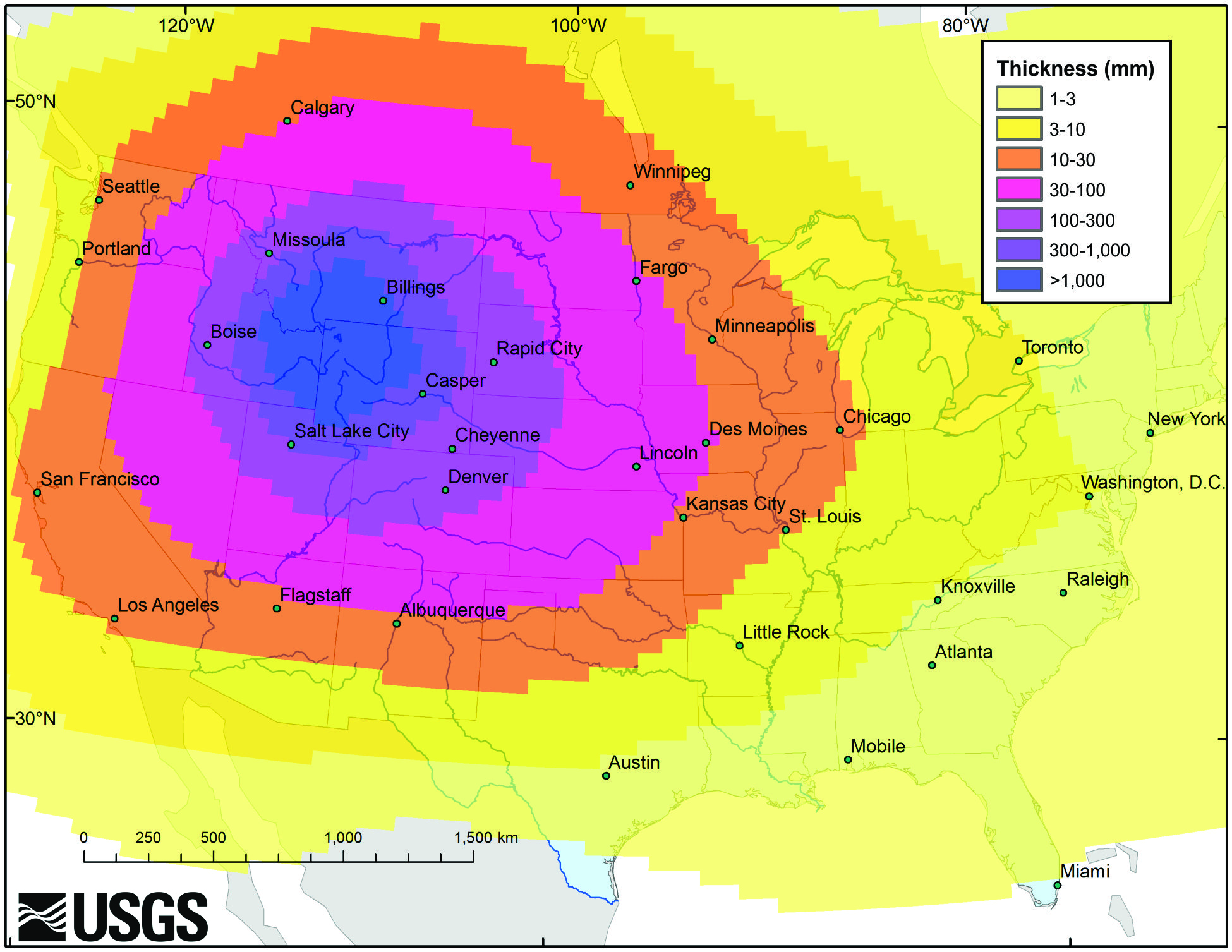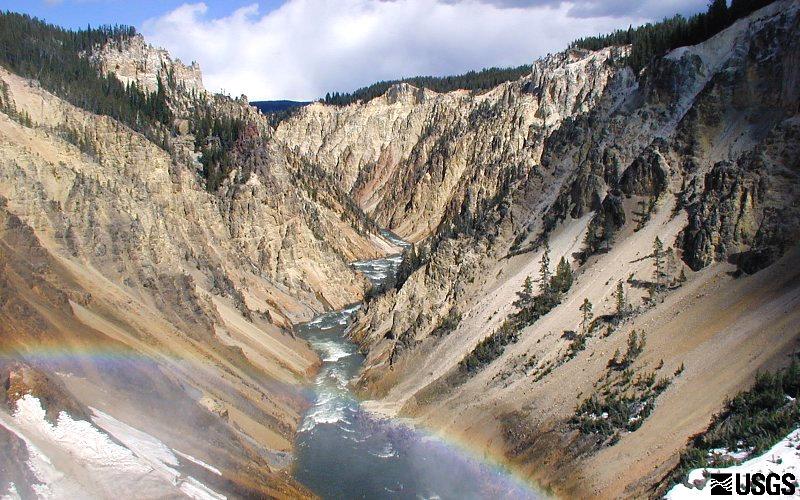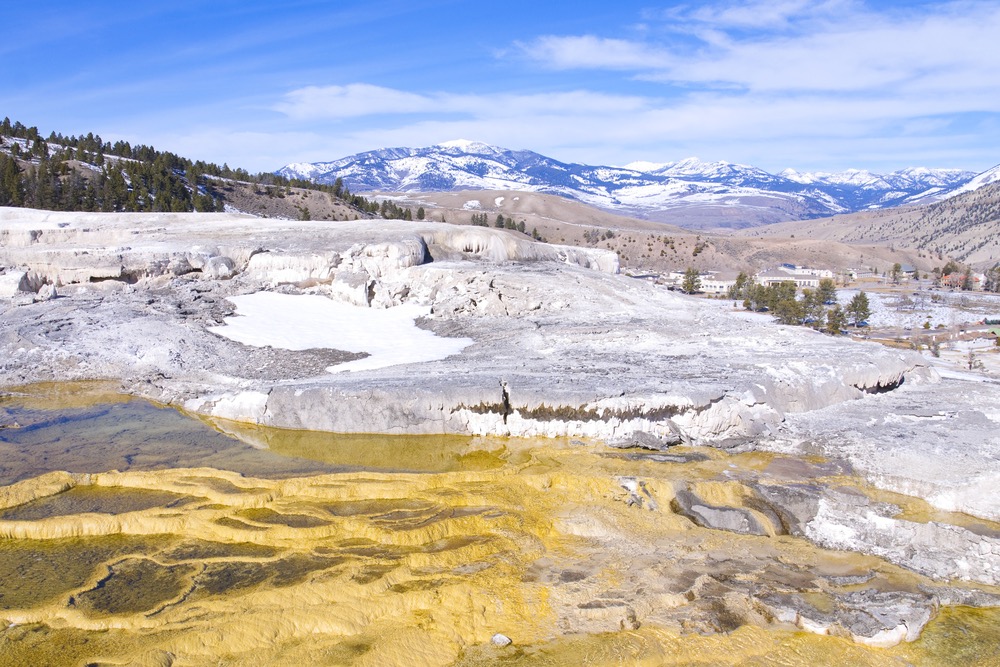When the Yellowstone Caldera Erupted Again What Are the Possible Harda Does It Posea Threat Now
What Would Happen If Yellowstone's Supervolcano Erupted?
Scientists at the U.S. Geological Survey'south (USGS) Yellowstone Volcano Observatory always pooh-pooh these worrisome memes, but that doesn't mean researchers are ignoring the possible consequences of a supereruption. Along with forecasting the damage, scientists constantly monitor the region for signs of molten rock tunneling hush-hush. Scientists scrutinize by supereruptions, as well as smaller volcanic blasts, to predict what would happen if the Yellowstone Volcano did blow.
Here'south a deeper look at whether Yellowstone's volcano would fire up a global catastrophe.
Probing Yellowstone'southward past
Most of Yellowstone National Park sits inside three overlapping calderas. The shallow, bowl-shaped depressions formed when an underground magma chamber erupted at Yellowstone. Each time, and then much fabric spewed out that the basis collapsed downward, creating a caldera. The massive blasts struck 2.ane million, 1.3 1000000 and 640,000 years ago. These past eruptions serve as clues to understanding what would happen if there was another Yellowstone megaexplosion. [Yellowstone and Yosemite: Two of the World's Oldest National Parks (Photos)]

If a hereafter supereruption resembles its predecessors, so flowing lava won't be much of a threat. The older Yellowstone lava flows never traveled much farther than the park boundaries, according to the USGS. For volcanologists, the biggest worry is wind-flung ash. Imagine a circumvolve about 500 miles (800 kilometers) beyond surrounding Yellowstone; studies advise the region inside this circumvolve might meet more than 4 inches (10 centimeters) of ash on the ground, scientists reported Aug. 27, 2014, in the journal Geochemistry, Geophysics, Geosystems.
The ash would be pretty devastating for the United States, scientists predict. The fallout would include short-term destruction of Midwest agronomics, and rivers and streams would be clogged by greyness muck.
People living in the Pacific Northwest might also be choking on Yellowstone's fallout.
"People who live upwind from eruptions need to be concerned about the big ones," said Larry Mastin, a USGS volcanologist and lead author of the 2014 ash study. Big eruptions often spawn behemothic umbrella clouds that button ash upwind beyond one-half the continent, Mastin said. These clouds become their name because the broad, flat cloud hovering over the volcano resembles an umbrella. "An umbrella deject fundamentally changes how ash is distributed," Mastin said.
Simply California and Florida, which grow near of the country'south fruits and vegetables, would see simply a dusting of ash.
A smelly climate shift
Yellowstone Volcano'south next supereruption is probable to spew vast quantities of gases such equally sulfur dioxide, which forms a sulfur aerosol that absorbs sunlight and reflects some of information technology back to infinite. The resulting climate cooling could last up to a decade. The temporary climate shift could modify rainfall patterns, and, forth with severe frosts, cause widespread crop losses and famine.

But a Yellowstone megablast would not wipe out life on Earth. In that location were no extinctions subsequently its last 3 enormous eruptions, nor take other supereruptions triggered extinctions in the last few million years. [Wipeout: History's 7 Most Mysterious Extinctions]
"Are we all going to dice if Yellowstone erupts? Almost certainly the answer is no," said Jamie Farrell, a Yellowstone skilful and assistant research professor at the University of Utah. "There take been quite a few supereruptions in the by couple meg years, and nosotros're still around."
Withal, scientists agree in that location is still much to learn about the global effects of supereruptions. The problem is that these massive outbursts are rare, striking somewhere on Earth but once or twice every meg years, one study establish. "We know from the geologic evidence that these were huge eruptions, just most of them occurred long enough in the past that we don't have much detail on what their consequences were," Mastin said. "These events take been and then exceptional that our communication has been not to worry near it."
A far more probable impairment scenario comes from the less predictable hazards — large earthquakes and hydrothermal blasts in the areas where tourists roam. "These pose a huge run a risk and could have a huge impact on people," Farrell said.
Supereruption reports are exaggerated
Human civilization volition surely survive a supereruption, so let's bust another myth. There is no pool of molten rock churning beneath Yellowstone's iconic geysers and mud pots. The Earth's chaff and pall beneath Yellowstone are indeed hot, but they are by and large solid, with pocket-sized pockets of molten rock scattered throughout, similar water within a sponge. Almost 9 percent of the hot blob is molten, and the remainder is solid, scientists reported on May fifteen, 2015, in the journal Science. This magma bedchamber rests betwixt 3 to half-dozen miles (5 to ten km) below the park.
Estimates vary, but a magma sleeping accommodation may need to accomplish nearly 50 percent melt before molten rock collects and forces its fashion out. "Information technology doesn't wait similar at this signal that the [Yellowstone] magma reservoir is ready for an eruption," said Farrell, co-writer of the 2015 study in the journal Scientific discipline. [Can You Outrun a Supervolcano? Maybe, Study Finds]
How exercise researchers measure the magma? Seismic waves travel more than slowly through hot or partially molten stone than they do through normal rock, so scientists tin can see where the magma is stored, and how much is there, by mapping out where seismic waves travel more slowly, Farrell said.
The magma storage region is not growing in size, either, at least for as long every bit scientists have monitored the park'due south underground. "It'south always been this size, it'south just nosotros're getting meliorate at seeing it," Farrell said.

Scout out for piffling eruptions
As with magma mapping, the science of forecasting volcanic eruptions is ever improving. Nigh scientists think that magma buildup would be detectable for weeks, perhaps years, preceding a major Yellowstone eruption. Warning signs would include distinctive earthquake swarms, gas emissions and rapid footing deformation.
Someone who knows about these warning signals might look at the park today and recollect, "Whoa, something weird is going on!" Yellowstone is a living volcano, and there are always small earthquakes causing tremors, and gas seeping from the ground. The volcano fifty-fifty breathes — the ground surface swells and sinks every bit gases and fluids motion around the volcanic "plumbing" arrangement beneath the park.
But the day-to-twenty-four hour period shaking in the park does not portend doom. The Yellowstone Volcano Observatory has never seen alarm signs of an impending eruption at the park, co-ordinate to the USGS.
What are scientists looking for? For one, the distinctive earthquakes triggered by moving molten stone. Magma tunneling underground sets off seismic signals that are different from those generated past slipping fault lines. "We would see earthquakes moving in a pattern and getting shallower and shallower," Farrell said. To learn about the earthquake patterns to wait for, revisit the 2014 eruption of Bardarbunga Volcano in Republic of iceland. Both amateurs and experts "watched" Bardarbunga's magma rise underground by tracking earthquakes. The eventual surface breakthrough was almost immediately appear on Twitter and other social media. Equally with Republic of iceland, all of Yellowstone'south seismic information is publicly bachelor through the U.S. Geological Survey's Yellowstone Volcano Observatory and the University of Utah.
"Nosotros would take a good thought that magma is moving upwards into the shallow depths," Farrell said. "The bottom line is, nosotros don't know when or if it volition erupt again, but we would take adequate warning."
Follow united states of america @livescience , Facebook & Google+ . Original article on Alive Scientific discipline.
Source: https://www.livescience.com/20714-yellowstone-supervolcano-eruption.html

0 Response to "When the Yellowstone Caldera Erupted Again What Are the Possible Harda Does It Posea Threat Now"
Post a Comment